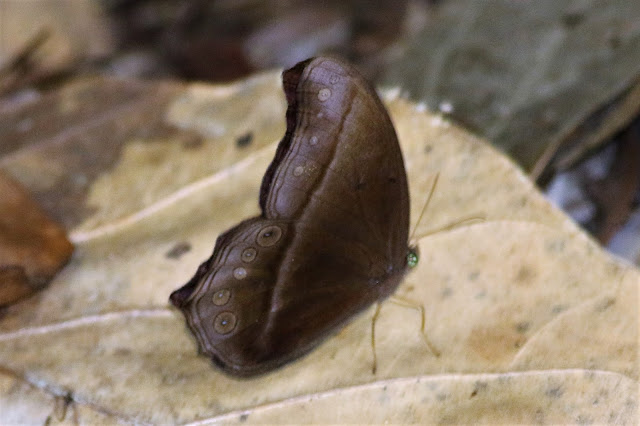The advantage of staying near a jungle patch is that you will get to see many wildlife including butterflies. While many butterflies would prefer the deeper and shady forest in this bone-dry month but occasionally they do come out too. Here are just some of them which were seen in the month of February.
Common Tree Nymph (Idea stolli logani)
Its local name is: "Bidadari Pohon Biasa"
One of the very few butterflies which allows you to take its flight photos.
Like a flying polka-dot tissue paper. The Common Tree Nymph has three spots on space 7 of its hindwing as indicated here. The "Malayan Tree-Nymph" (Idea lynceus logani) apparently only has two spots.
Such an elegant and gentle butterfly.
In butterflies, it was said that polymorphism occurs more frequently in females than in males.
"Malay Count" (Tanaecia godartii asoka) - female
The male of the above species has different colors.
Its a rather uncommon butterfly.
Straight Banded Catseye (Coelites epiminthia epiminthia) - without flash
Straight Banded Catseye (Coelites epiminthia epiminthia) - with flash
I think there could be some ambiguity on its scientific name. Was it "Mycalesis fusca fusca" or "Mydosama fuscum fuscum"? - Answer: I guess it depends on which stream you are following.
Chocolate Pansy (Junonia hedonia ida)
Another common butterfly
Did they named it after Tele Santana?
Wish it had open its wings slightly wider.
Chocolate Grass Yellow (Eurema sari sodalis)
Common Sailer (Neptis hylas papaja)
Common Four-Ring (Ypthima huebneri)
Malayan Five-ring (Ypthima horsfieldi humei) - its ocelli on space 4 & 5 are equal size.
One of the subtle differences to look for between a 'Malayan Five-ring' and a 'Malayan Six-ring' (Ypthima horsfieldii humei) is the alignment of their ocellis / rings whereby the rings of a 'Malayan Five-ring' are not aligned / straight, like those of the 'Malayan Six-ring'.
Could the above butterflies resemble a 'Nacaduba' or perhaps a 'Prosotas' ?
A game changer for science or maybe the textile industries etc ?
The above photo might one day expunge the science theory that says adult butterflies don't secrete silk. Entomologist might want to expand their research on what was the 'thing' that this butterfly was secreting cause they are certainly not spider webs.
Branded Imperial (Eooxylides tharis distanti)
Common Mormon (Papilo polytes romulus)
Lastly here are some insects which looks like a moth and butterfly but they are neither of them. They are actually plant hoppers.
The above is a 'Pochazia transversa' (Ricaniid planthopper)
Flatid Planthopper - Ormenaria rufifascia (Walker) / lawana candida
According to literature, some planthoppers are considered a pest.
IN BETWEEN THE LIGHT AND DARKNESS, I THRIVE













































